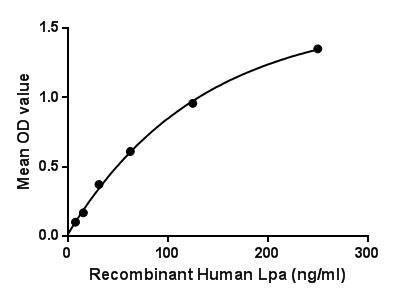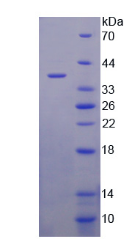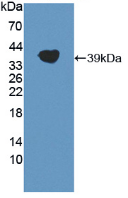
Details
ACTIVITY TEST
Buffer Formulation PBS, pH7.4, containing 0.01% SKL, 5% Trehalose. Traits Freeze-dried powder Purity > 95% Isoelectric Point 8.4 Applications Cell culture; Activity Assays.

Lipoprotein, a (Lpa) is a lipoprotein subclass. Lpa is assembled at the hepatocyte cell membrane surface, while other scenarios exist with regard to the location of assembly. It mainly exists in plasma. Lpa contributes to the process of atherogenesis. It also may enhance coagulation by inhibiting the function of tissue factor pathway inhibitor. Lpa carries cholesterol and binds atherogenic proinflammatory oxidized phospholipids as a preferential carrier of oxidized phospholipids in human plasma, which attract inflammatory cells to vessel walls and leads to smooth muscle cell proliferation. Moreover, Lpa also is hypothesized to be involved in wound healing and tissue repair, interacting with components of the vascular wall and extra cellular matrix. Besides, Fibronectin (FN) has been identified as an interactor of Lpa, thus a binding ELISA assay was conducted to detect the interaction of recombinant human Lpa and recombinant human FN. Briefly, Lpa were diluted serially in PBS, with 0.01% BSA (pH 7.4). Duplicate samples of 100μL were then transferred to FN-coated microtiter wells and incubated for 2h at 37℃. Wells were washed with PBST and incubated for 1h with anti-Lpa pAb, then aspirated and washed 3 times. After incubation with HRP labelled secondary antibody, wells were aspirated and washed 3 times. With the addition of substrate solution, wells were incubated 15-25 minutes at 37℃. Finally, add 50µL stop solution to the wells and read at 450nm immediately. The binding activity of Lpa and FN was shown in Figure 1, and this effect was in a dose dependent manner.
Figure. The binding activity of Lpa with FN.USAGE
Reconstitute in 10mM PBS (pH7.4) to a concentration of 0.1-1.0 mg/mL. Do not vortex.
STORAGE
Avoid repeated freeze/thaw cycles. Store at 2-8°C for one month. Aliquot and store at -80°C for 12 months.
STABILITY
The thermal stability is described by the loss rate. The loss rate was determined by accelerated thermal degradation test, that is, incubate the protein at 37°C for 48h, and no obvious degradation and precipitation were observed. The loss rate is less than 5% within the expiration date under appropriate storage condition.
Image

Figure. SDS-PAGE

Figure. Western Blot
Partial purchase records(bought amounts latest0)
User Comment(Total0User Comment Num)
- No comment


 +86 571 56623320
+86 571 56623320




